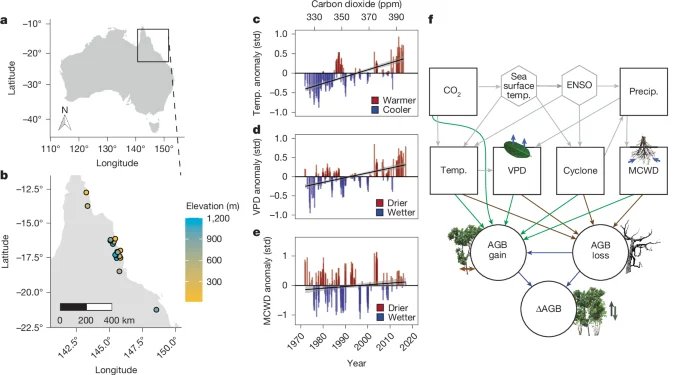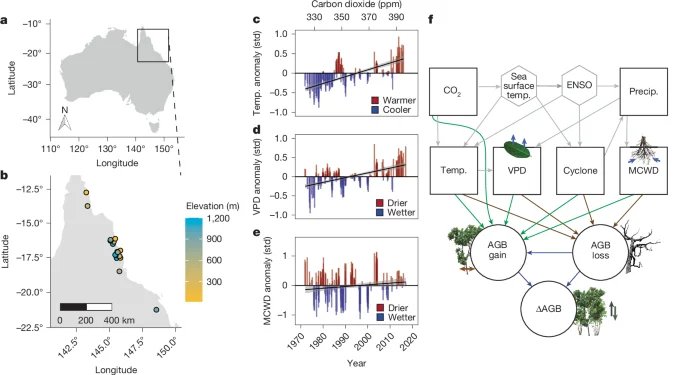Aboveground Biomass In Australian Tropical Forests Now A Net Carbon Source

Aboveground Biomass In Australian Tropical Forests Now A Net Carbon Source

uaetodaynews.com — Aboveground biomass in Australian tropical forests now a net carbon source
Pan, Y. et al. The enduring world forest carbon sink. Nature 631, 563–569 (2024).
Google Scholar
Cox, P. M. et al. Sensitivity of tropical carbon to climate change constrained by carbon dioxide variability. Nature 494, 341–344 (2013).
Google Scholar
Koch, A., Hubau, W. & Lewis, S. L. Earth System Models are not capturing present‐day tropical forest carbon dynamics. Earths Future 9, e2020EF001874 (2021).
Google Scholar
Bauman, D. et al. Tropical tree mortality has increased with rising atmospheric water stress. Nature 608, 528–533 (2022).
Google Scholar
Brienen, R. J. W. et al. Long-term decline of the Amazon carbon sink. Nature 519, 344–348 (2015).
Google Scholar
Gatti, L. V. et al. Amazonia as a carbon source linked to deforestation and climate change. Nature 595, 388–393 (2021).
Google Scholar
Hubau, W. et al. Asynchronous carbon sink saturation in African and Amazonian tropical forests. Nature 579, 80–87 (2020).
Google Scholar
Arif, S. & MacNeil, M. A. Applying the structural causal model framework for observational causal inference in ecology. Ecol. Monogr. 93, e1554 (2023).
Google Scholar
Segura-Garcia, C., Bauman, D., Arruda, V. L. S., Alencar, A. A. C. & Menor, I. O. Human land occupation regulates the effect of the climate on the burned area of the Brazilian Cerrado. Commun. Earth Environ. 5, 361 (2024).
Google Scholar
Pearl, J. Causal inference in statistics: an overview. Stat. Surv. 3, 96–146 (2009).
Google Scholar
Murphy, H. T., Bradford, M. G., Dalongeville, A., Ford, A. J. & Metcalfe, D. J. No evidence for long-term increases in biomass and stem density in the tropical rain forests of Australia. J. Ecol. 101, 1589–1597 (2013).
Google Scholar
Cavaleri, M. A. et al. Tropical rainforest carbon sink declines during El Niño as a result of reduced photosynthesis and increased respiration rates. New Phytol. 216, 136–149 (2017).
Google Scholar
Rifai, S. W. et al. ENSO drives interannual variation of forest woody growth across the tropics. Philos. Trans. R. Soc. Lond. B Biol. Sci. 373, 20170410 (2018).
Google Scholar
Grossiord, C. et al. Plant responses to rising vapor pressure deficit. New Phytol. 226, 1550–1566 (2020).
Google Scholar
Feldpausch, T. R. et al. Amazon forest response to repeated droughts. Glob. Biogeochem. Cycles 30, 964–982 (2016).
Google Scholar
Sanchez-Martinez, P. et al. Amazon rainforest adjusts to long-term experimental drought. Nat. Ecol. Evol. 9, 970–979 (2025).
Parker, C. L., Bruyère, C. L., Mooney, P. A. & Lynch, A. H. The response of land-falling tropical cyclone characteristics to projected climate change in northeast Australia. Clim. Dyn. 51, 3467–3485 (2018).
Google Scholar
Lavendar, S. L. & Walsh, K. J. E. Dynamically downscaled simulations of Australian region tropical cyclones in current and future climates. Geophys. Res. Lett. 38, 1–6 (2011).
Ibanez, T. et al. Globally consistent impact of tropical cyclones on the structure of tropical and subtropical forests. J. Ecol. 107, 279–292 (2018).
Google Scholar
Murphy, H. T., Metcalfe, D. J., Bradford, M. G. & Ford, A. J. Community divergence in a tropical forest following a severe cyclone. Austral Ecol. 39, 696–709 (2014).
Google Scholar
Murphy, H. T. & Metcalfe, D. J. The perfect storm: Weed invasion and intense storms in tropical forests. Austral Ecol. 41, 864–874 (2016).
Google Scholar
Brienen, R. J. W. et al. Forest carbon sink neutralized by pervasive growth-lifespan trade-offs. Nat. Commun. 11, 4241 (2020).
Google Scholar
Montreal Process Implementation Group for Australia and National Forest Inventory Steering Committee. Australia’s State of the Forests Report 2018 (ABARES, 2018).
Feldpausch, T. R. et al. Tree height integrated into pantropical forest biomass estimates. Biogeosciences 9, 3381–3403 (2012).
Google Scholar
Bradford, M. G., Murphy, H. T., Ford, A. J., Hogan, D. L. & J., M. D. in Ecology Vol. 95, 2362 (ESA, 2014).
Bauman, D. et al. Tropical tree growth sensitivity to climate is driven by species intrinsic growth rate and leaf traits. Glob. Chang. Biol. 28, 1414–1432 (2021).
Google Scholar
Bradford, M. & Murphy, H. T. The importance of large-diameter trees in the wet tropical rainforests of Australia. PLoS One 14, e0208377 (2019).
Google Scholar
Rowland, L. et al. Shock and stabilisation following long-term drought in tropical forest from 15 years of litterfall dynamics. J. Ecol. 106, 1673–1682 (2017).
Google Scholar
Staal, A. et al. Hysteresis of tropical forests in the 21st century. Nat. Commun. 11, 4978 (2020).
Google Scholar
Rifai, S. W. et al. Thirty-eight years of CO2 fertilization has outpaced growing aridity to drive greening of Australian woody ecosystems. Biogeosciences 19, 491–515 (2022).
Google Scholar
Jiang, M. et al. The fate of carbon in a mature forest under carbon dioxide enrichment. Nature 580, 227–231 (2020).
Google Scholar
Cunha, H. F. V. et al. Direct evidence for phosphorus limitation on Amazon forest productivity. Nature 608, 558–562 (2022).
Google Scholar
Jiang, M. et al. Microbial competition for phosphorus limits the CO2 response of a mature forest. Nature 630, 660–665 (2024).
Google Scholar
Crous, K. Y. et al. Leaf warming in the canopy of mature tropical trees reduced photosynthesis due to downregulation of photosynthetic capacity and reduced stomatal conductance. New Phytol. 245, 1421–1436 (2024).
Chambers, J. Q., Higuchi, N., Schimel, J. P., Ferreira, L. V. & Melack, J. M. Decomposition and carbon cycling of dead trees in tropical forests of the central Amazon. Oecologia 122, 380–388 (2000).
Google Scholar
Walker, W. S. et al. The global potential for increased storage of carbon on land. Proc. Natl Acad. Sci. USA 119, e2111312119 (2022).
Google Scholar
Raich, J. W. & Schlesinger, W. H. The global carbon dioxide flux in soil respiration and its relationship to vegetation and climate. Tellus B 44, 81–99 (1992).
Google Scholar
Viscarra Rossel, R. A., Webster, R., Bui, E. N. & Baldock, J. A. Baseline map of organic carbon in Australian soil to support national carbon accounting and monitoring under climate change. Glob. Chang. Biol. 20, 2953–2970 (2014).
Google Scholar
Nottingham, A. T. et al. Microbial diversity declines in warmed tropical soil and respiration rise exceed predictions as communities adapt. Nat. Microbiol. 7, 1650–1660 (2022).
Google Scholar
Sotta, E. D. et al. Effects of an induced drought on soil carbon dioxide (CO2) efflux and soil CO2 production in an Eastern Amazonian rainforest, Brazil. Glob. Chang. Biol. 13, 2218–2229 (2007).
Google Scholar
Luo, Z., Feng, W., Luo, Y., Baldock, J. & Wang, E. Soil organic carbon dynamics jointly controlled by climate, carbon inputs, soil properties and soil carbon fractions. Glob. Chang. Biol. 23, 4430–4439 (2017).
Google Scholar
Smith, M. N. et al. Empirical evidence for resilience of tropical forest photosynthesis in a warmer world. Nat. Plants 6, 1225–1230 (2020).
Google Scholar
Allen, C. D., Breshears, D. D. & McDowell, N. G. On underestimation of global vulnerability to tree mortality and forest die‐off from hotter drought in the Anthropocene. Ecosphere 6, 1–55 (2015).
Google Scholar
Hammond, W. M. et al. Global field observations of tree die-off reveal hotter-drought fingerprint for Earth’s forests. Nat. Commun. 13, 1761 (2022).
Google Scholar
Middleby, K. B., Cheesman, A. W. & Cernusak, L. A. Impacts of elevated temperature and vapour pressure deficit on leaf gas exchange and plant growth across six tropical rainforest tree species. New Phytol. 243, 648–661 (2024).
Google Scholar
Slot, M., Rifai, S. W., Eze, C. E. & Winter, K. The stomatal response to vapor pressure deficit drives the apparent temperature response of photosynthesis in tropical forests. New Phytol. 244, 1238–1249 (2024).
Google Scholar
Duan, H. et al. CO2 and temperature effects on morphological and physiological traits affecting risk of drought-induced mortality. Tree Physiol. 38, 1138–1151 (2018).
Google Scholar
Breshears, D. D. et al. Underappreciated plant vulnerabilities to heat waves. New Phytol. 231, 32–39 (2021).
Google Scholar
Doughty, C. E. et al. Tropical forests are approaching critical temperature thresholds. Nature 621, 105–111 (2023).
Google Scholar
Cunningham, S. C. & Read, J. Foliar temperature tolerance of temperate and tropical evergreen rain forest trees of Australia. Tree Physiol. 26, 1435–1443 (2006).
Google Scholar
Menezes-Silva, P. E. et al. Different ways to die in a changing world: Consequences of climate change for tree species performance and survival through an ecophysiological perspective. Ecol. Evol. 9, 11979–11999 (2019).
Google Scholar
Allen, C. D. et al. A global overview of drought and heat-induced tree mortality reveals emerging climate change risks for forests. Forest Ecol. Manage. 259, 660–684 (2010).
Google Scholar
Teskey, R. et al. Responses of tree species to heat waves and extreme heat events. Plant Cell Environ. 38, 1699–1712 (2015).
Google Scholar
Turton, S. M. Landscape-scale impacts of Cyclone Larry on the forests of northeast Australia, including comparisons with previous cyclones impacting the region between 1858 and 2006. Austral Ecol. 33, 409–416 (2008).
Google Scholar
Qie, L. et al. Long-term carbon sink in Borneo’s forests halted by drought and vulnerable to edge effects. Nat. Commun. 8, 1966 (2017).
Google Scholar
Ibanez, T. et al. Damage to tropical forests caused by cyclones is driven by wind speed but mediated by topographical exposure and tree characteristics. Glob. Chang. Biol. 30, e17317 (2024).
Google Scholar
Metcalfe, D. J., Bradford, M. G. & Ford, A. J. Cyclone damage to tropical rain forests: Species- and community-level impacts. Austral Ecol. 33, 432–441 (2008).
Google Scholar
Connell, J. H. & Green, P. T. Seedling dynamics over thirty-two years in a tropical rain forest tree. Ecology 81, 568–584 (2000).
Google Scholar
Berenguer, E. et al. A large-scale field assessment of carbon stocks in human-modified tropical forests. Glob. Chang. Biol. 20, 3713–3726 (2014).
Google Scholar
Cummings, D. L., Boone Kauffman, J., Perry, D. A. & Flint Hughes, R. Aboveground biomass and structure of rainforests in the southwestern Brazilian Amazon. Forest Ecol. Manage. 163, 293–307 (2002).
Google Scholar
Malhi, Y. et al. The regional variation of aboveground live biomass in old-growth Amazonian forests. Glob. Chang. Biol. 12, 1107–1138 (2006).
Google Scholar
Djuikouo, M. N. K., Doucet, J.-L., Nguembou, C. K., Lewis, S. L. & Sonké, B. Diversity and aboveground biomass in three tropical forest types in the Dja Biosphere Reserve, Cameroon. Afr. J. Ecol. 48, 1053–1063 (2010).
Google Scholar
Glenday, J. Carbon storage and emissions offset potential in an East African tropical rainforest. Forest Ecol. Manage. 235, 72–83 (2006).
Google Scholar
Lewis, S. L. et al. Above-ground biomass and structure of 260 African tropical forests. Philos. Trans. R. Soc. Lond. B Biol. Sci. 368, 20120295 (2013).
Google Scholar
Kotowska, M. M., Leuschner, C., Triadiati, T., Meriem, S. & Hertel, D. Quantifying above- and belowground biomass carbon loss with forest conversion in tropical lowlands of Sumatra (Indonesia). Glob. Chang. Biol. 21, 3620–3634 (2015).
Google Scholar
Katayama, A. et al. Carbon allocation in a Bornean tropical rainforest without dry seasons. J. Plant Res. 126, 505–515 (2013).
Google Scholar
Slik, J. W. F. et al. Environmental correlates of tree biomass, basal area, wood specific gravity and stem density gradients in Borneo’s tropical forests. Glob. Ecol. Biogeogr. 19, 50–60 (2010).
Google Scholar
Martin, A. R., Doraisami, M. & Thomas, S. C. Global patterns in wood carbon concentration across the world’s trees and forests. Nat. Geosci. 11, 915–920 (2018).
Google Scholar
Graham, A. E. (ed.) The CSIRO Rainforest Permanent Plots of North Queensland: Site, Structural, Floristic and Edaphic Descriptions (Rainforest CRC, Cairns, 2006).
Talbot, J. et al. Methods to estimate aboveground wood productivity from long-term forest inventory plots. Forest Ecol. Manage. 320, 30–38 (2014).
Google Scholar
Chave, J. et al. Tree allometry and improved estimation of carbon stocks and balance in tropical forests. Oecologia 145, 87–99 (2005).
Google Scholar
Ledo, A. et al. Re-evaluation of individual diameter:height allometric models to improve biomass estimation of tropical trees. Ecol. Appl. 26, 2376–2382 (2016).
Google Scholar
Hutchinson, M. F., Xu, T., Kesteven, J. L., Marang, I. J. & Evans, B. J. ANUClimate v2.0. NCI Data Catalogue https://doi.org/10.25914/60a10aa56dd1b (2022).
Abatzoglou, J. T., Dobrowski, S. Z., Parks, S. A. & Hegewisch, K. C. TerraClimate, a high-resolution global dataset of monthly climate and climatic water balance from 1958-2015. Sci. Data 5, 170191 (2018).
Google Scholar
Dlugokencky, E. J., Mund, J. W., Crotwell, A. M., Crotwell, M. J. & Thoning, K. W. NOAA Global Greenhouse Gas Reference Network Flask-Air Sample Measurements of CO2, CH4, CO, N2O, H2, SF6 and isotopic ratios at Global and Regional Background Sites, 1997-2020, Version: 2021-07-30 (ed. NOAA GML Carbon Cycle Cooperative Global Air Sampling Network) (GML, 2021).
Aragão, L. E. O. C. et al. Spatial patterns and fire response of recent Amazonian droughts. Geophys. Res. Lett. 34, L07701 (2007).
Google Scholar
Wood, S. N. Fast stable restricted maximum likelihood and marginal likelihood estimation of semiparametric generalized linear models. J. R. Stat. Soc. 73, 3–36 (2011).
Google Scholar
Cinelli, C., Forney, A. & Pearl, J. A crash course in good and bad controls. Sociol. Meth. Res. 53, https://doi.org/10.1177/00491241221099552 (2022).
Adams, H. D. et al. A multi-species synthesis of physiological mechanisms in drought-induced tree mortality. Nat. Ecol. Evol. 1, 1285–1291 (2017).
Google Scholar
Dray, S., Legendre, P. & Peres-Neto, P. R. Spatial modelling: a comprehensive framework for principal coordinate analysis of neighbour matrices (PCNM). Ecol. Model. 196, 483–493 (2006).
Google Scholar
Bauman, D., Drouet, T., Dray, S. & Vleminckx, J. Disentangling good from bad practices in the selection of spatial or phylogenetic eigenvectors. Ecography 41, 1638–1649 (2018).
Google Scholar
Dray, S. et al. R package version 0.3-24: adespatial: multivariate multiscale spatial analysis. CRAN https://CRAN.R-project.org/package=adespatial (2024).
Bauman, D., Drouet, T., Fortin, M. J. & Dray, S. Optimizing the choice of a spatial weighting matrix in eigenvector‐based methods. Ecology 99, 2159–2166 (2018).
Google Scholar
Anderson, M. J. & Legendre, P. An empirical comparison of permutation methods for tests of partial regression coefficients in a linear model. J. Stat. Comput. Simul. 62, 271–303 (1999).
Google Scholar
McElreath, R. Statistical Rethinking: A Bayesian Course with Examples in R and STAN 2nd edn (Chapman and Hall, 2020).
Lenth, R. R package v.1.10: emmeans: estimated marginal means, aka least-squares means. CRAN https://CRAN.R-project.org/package=emmeans (2024).
R Core Team. R: a language and environment for statistical computing. https://www.R-project.org/ (R Foundation for Statistical Computing, 2025).
Disclaimer: This news article has been republished exactly as it appeared on its original source, without any modification.
We do not take any responsibility for its content, which remains solely the responsibility of the original publisher.
Disclaimer: This news article has been republished exactly as it appeared on its original source, without any modification.
We do not take any responsibility for its content, which remains solely the responsibility of the original publisher.
Author: uaetodaynews
Published on: 2025-10-15 21:43:00
Source: uaetodaynews.com





